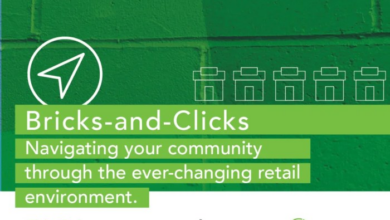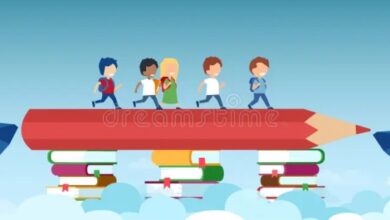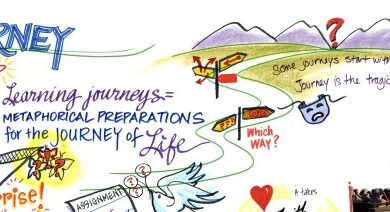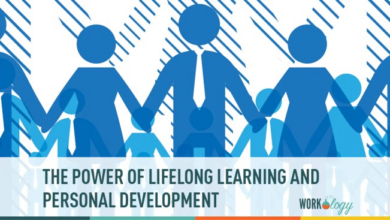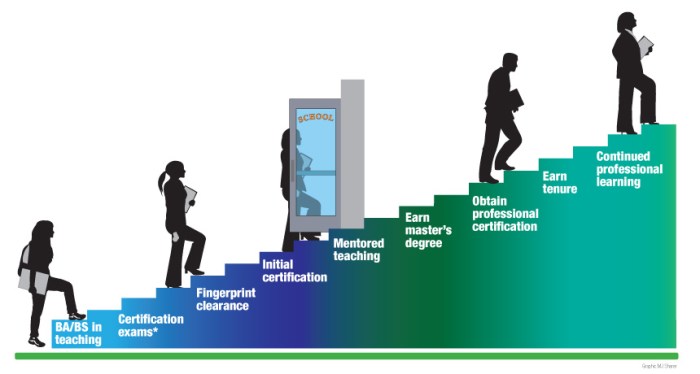
How to become a teacher? This comprehensive guide dives deep into the world of education, offering a roadmap for aspiring educators. From navigating the necessary educational requirements to mastering classroom management strategies, this resource covers every crucial aspect of the teaching profession. It delves into the essential skills, qualities, and methodologies needed to thrive in the classroom, providing insights into fostering a positive learning environment and adapting lessons for diverse student needs.
This detailed exploration covers everything from the specific degrees and certifications required for different teaching levels to the importance of professional development and finding teaching positions. The guide includes practical strategies for lesson planning, curriculum development, and integrating technology into the classroom. It also examines the role of the teacher in a diverse classroom and offers insights into inclusive teaching practices.
Finally, it touches on the crucial skills and qualities effective teachers possess, such as communication, interpersonal skills, and pedagogical approaches.
Educational Requirements: How To Become A Teacher
Becoming a teacher requires a strong foundation in education, a deep understanding of the subject matter, and dedication to student growth. The specific requirements vary significantly based on the level of education – elementary, secondary, or higher education – and the subject area. This section details the necessary steps for aspiring educators at each level.The path to becoming a teacher involves a structured academic journey.
This includes completing specific degree programs, gaining practical experience, and often obtaining professional certifications. The educational requirements are tailored to ensure teachers possess the knowledge and skills needed to effectively instruct students at different developmental stages.
Elementary Teacher Requirements
Elementary teachers play a crucial role in nurturing young minds. They foster a love for learning and lay the groundwork for future academic success. These teachers need a strong grasp of child development and pedagogical strategies to cater to the unique needs of elementary students.
- A bachelor’s degree in education, often with a specialization in early childhood education or general elementary education, is typically required. This degree program usually incorporates courses on child development, classroom management, and various teaching methodologies.
- Teacher certification is essential for licensure. State requirements vary, but typically include passing a standardized test (like Praxis) and completing a supervised student teaching experience.
- Further education, such as a master’s degree in education or a related field, can enhance career opportunities and potentially increase earning potential.
Secondary Teacher Requirements
Secondary teachers are responsible for guiding students through more advanced academic concepts and preparing them for higher education or the workforce. Their expertise in a specific subject area is crucial for effective instruction.
- A bachelor’s degree in the subject area is usually the initial requirement. For example, a prospective history teacher would typically earn a bachelor’s degree in history. However, a master’s degree in education or a related field can significantly strengthen a candidate’s application and increase their teaching options.
- Teacher certification, encompassing subject-specific knowledge and pedagogical skills, is a critical component. This often involves passing subject-specific Praxis exams and fulfilling state-mandated student teaching hours.
- Specialized certification in particular secondary subjects, such as math or science, may be required depending on the state and subject area.
Higher Education Teacher Requirements
Higher education teachers, or professors, are expected to be experts in their field, conducting research, mentoring students, and contributing to the intellectual discourse. Their role is to not only impart knowledge but also to inspire critical thinking and intellectual curiosity.
- A doctoral degree (Ph.D.) in the specific discipline is almost always required for higher education positions. The doctoral program necessitates in-depth research, publishing, and demonstrating expertise in the field.
- Postdoctoral research and experience can significantly enhance an applicant’s profile and competitiveness in the job market.
- Publications and presentations in academic journals and conferences are highly valued in this field, demonstrating a commitment to ongoing scholarship.
Academic Progression Table
The following table Artikels the typical academic progression for aspiring teachers in different fields.
| Level | Degree | Specialization |
|---|---|---|
| Elementary | Bachelor’s in Education | Early Childhood, General Education |
| Secondary | Bachelor’s/Master’s in Education | Specific Subject Area (e.g., History, Math, Science) |
| Higher Education | Doctoral Degree (Ph.D.) | Specific Discipline (e.g., History, Mathematics, Biology) |
Skills and Qualities of Effective Teachers
Becoming an effective teacher transcends simply possessing the required educational qualifications. It demands a multifaceted approach encompassing a deep understanding of subject matter, strong interpersonal skills, and a genuine passion for fostering learning. Successful educators cultivate a supportive and engaging classroom environment, enabling students to thrive academically and personally.Effective teaching is not a one-size-fits-all endeavor. Adaptability and the ability to tailor teaching strategies to diverse learning styles are crucial.
The most successful educators are those who can recognize and respond to the unique needs of each student, creating a personalized learning experience that resonates with individual motivations and learning preferences.
Essential Interpersonal Skills
Teachers need a robust toolkit of interpersonal skills to build strong relationships with students, parents, and colleagues. Empathy, active listening, and patience are paramount in navigating the complexities of the classroom. These skills allow teachers to understand and respond to students’ emotional needs, creating a safe and supportive environment for learning. Respectful communication is also critical in building trust and rapport.
Importance of Communication Skills in the Classroom
Effective communication is the cornerstone of a successful classroom. Teachers must possess strong verbal and nonverbal communication skills to convey information clearly and concisely. This includes using appropriate language, adapting their communication style to the age and developmental stage of their students, and actively seeking feedback to ensure understanding. Clear instructions and expectations set the stage for a productive learning environment.
Active listening plays an equally vital role, allowing teachers to understand student perspectives and concerns.
Pedagogical Approaches and Methodologies
A variety of pedagogical approaches and methodologies can enhance student engagement and learning. A flexible approach is essential, tailoring strategies to different age groups and subject matter.
- For younger students (early childhood and elementary), hands-on activities, play-based learning, and storytelling are often highly effective. These methods tap into children’s natural curiosity and encourage active participation. Visual aids and real-world examples are vital for making concepts concrete and relatable.
- Middle and high school students benefit from more structured discussions, collaborative projects, and opportunities for critical thinking. Encouraging students to explore different perspectives and engage in debate fosters a deeper understanding of complex topics. Role-playing, simulations, and guest speakers can further enrich the learning experience.
- Higher education often utilizes a variety of methods including lectures, discussions, research projects, and presentations. Creating opportunities for independent learning and research is vital at this level. Faculty mentoring and providing access to resources are crucial for student success.
Fostering a Positive Learning Environment
Creating a positive learning environment is fundamental to student success. Teachers can foster this environment by demonstrating respect, empathy, and inclusivity. Setting clear expectations and establishing a consistent routine creates a sense of structure and security. Recognizing and rewarding student effort and achievement reinforces positive behaviors. Encouraging collaboration and teamwork fosters a sense of community and belonging within the classroom.
Comparison of Teaching Styles
| Teaching Style | Description | Strengths | Weaknesses |
|---|---|---|---|
| Direct Instruction | This approach emphasizes teacher-centered learning with clear explanations and demonstrations. Teachers deliver information and students actively receive it. | Efficient for conveying large amounts of information. Structured and clear for students who thrive in a structured environment. | May not cater to diverse learning styles. Can be less engaging for students who prefer active learning or hands-on activities. May not encourage critical thinking or problem-solving skills. |
| Inquiry-Based Learning | Students explore questions and problems, formulating hypotheses and gathering data to reach conclusions. Teachers act as facilitators, guiding students through the process. | Promotes critical thinking, problem-solving skills, and a deeper understanding of concepts. Highly engaging and motivating for students who enjoy exploring and discovering. | Requires more time and preparation. May not be suitable for all topics or age groups. Requires a high level of student self-direction and independence. |
Classroom Management Strategies
Creating a positive and productive learning environment is crucial for student success. Effective classroom management goes beyond simply controlling behavior; it involves fostering a culture of respect, responsibility, and engagement. This necessitates understanding diverse approaches, implementing strategies for a positive atmosphere, and developing methods for addressing disruptive behavior proactively. Clear rules and expectations are fundamental to achieving a structured and supportive learning environment.Classroom management is not a one-size-fits-all solution.
A successful teacher recognizes that different students respond to various approaches. Strategies must be adaptable and responsive to individual needs while maintaining a consistent and predictable learning environment. The key is to establish a balance between maintaining order and fostering a stimulating learning atmosphere.
Different Approaches to Classroom Management
Various approaches to classroom management exist, each with its own strengths and weaknesses. Understanding these different styles allows teachers to tailor their strategies to specific classroom dynamics and student needs. Authoritative, democratic, and permissive styles all have unique characteristics and implications for student behavior and learning outcomes.
Strategies for Establishing and Maintaining a Positive Classroom Environment
A positive classroom environment is characterized by mutual respect, clear communication, and a sense of shared responsibility. Establishing clear routines and expectations from the beginning sets the stage for a successful learning experience. Activities that promote collaboration and teamwork can also foster a supportive atmosphere.
- Creating a Culture of Respect: Modeling respectful behavior and actively encouraging students to treat each other with kindness and consideration is essential. Establish clear expectations for communication and conflict resolution, including active listening and empathy. For example, if a student is interrupting another during a presentation, the teacher can intervene by saying, “Let’s give [student’s name] a chance to finish their thoughts before we move on.” This creates a safe space where students feel heard and valued.
- Building Relationships: Getting to know students as individuals and understanding their needs is vital. Teachers can build positive relationships by engaging in conversations, showing genuine interest, and actively listening to their concerns. Scheduling individual check-ins or creating a class journal can help establish a sense of community and support.
- Establishing Clear Routines and Procedures: Consistency is key. Clearly defined routines for transitions, assignments, and classroom procedures help reduce disruptions and build predictability. For instance, a consistent procedure for entering the classroom, retrieving materials, and completing assignments minimizes confusion and maximizes instructional time.
Methods for Handling Disruptive Behavior Effectively
Disruptive behavior is an inevitable part of the learning environment. Addressing such behavior requires a proactive approach that focuses on prevention and de-escalation. Understanding the root causes of disruptive behavior can help teachers respond more effectively.
- Proactive Strategies: Anticipating potential disruptions and proactively addressing underlying issues can prevent disruptive behaviors from escalating. Teachers can use pre-emptive strategies, like clear instructions and visual aids to avoid misunderstandings.
- Addressing Disruptive Behaviors: A clear and consistent response system for addressing disruptive behaviors is critical. Using positive reinforcement for desired behaviors and logical consequences for inappropriate actions helps students understand expectations and consequences. For instance, a student who consistently disrupts class discussions might lose their privileges to participate in class discussions for a specific period.
- Seeking Support: Collaboration with school counselors and administrators can provide valuable support for managing challenging student behaviors. Identifying potential underlying issues like anxiety or emotional difficulties can help create a more supportive approach. Teachers should be open to seeking support from specialists to address complex situations.
The Role of Creating Clear Rules and Expectations
Clear rules and expectations establish a framework for student behavior within the classroom. They provide a shared understanding of acceptable conduct and the consequences of violating these rules. Creating a classroom contract, where students contribute to the rules, can foster a sense of ownership and accountability.
- Developing Rules Together: Involving students in creating the rules and expectations fosters a sense of shared responsibility and understanding. This collaborative approach can lead to a better understanding of the rules, and students will be more willing to follow them.
- Communicating Expectations Clearly: Rules should be clearly written and displayed in the classroom. Regular reviews and reinforcement of the rules help maintain consistency and ensure that all students understand the expectations.
- Consistency in Enforcement: Consistent enforcement of rules is crucial for establishing a predictable learning environment. This helps students understand that their actions have consequences, and it reinforces the importance of following rules.
Resources for Further Research on Classroom Management Techniques
Numerous resources provide valuable insights into effective classroom management techniques. Exploring these resources can further enhance a teacher’s understanding of various approaches and strategies.
- Educational Journals: Academic journals and publications often publish research articles on classroom management.
- Professional Organizations: Teacher organizations and educational associations offer resources and training programs on classroom management.
- Online Courses and Workshops: Online platforms provide a wealth of resources for learning effective classroom management techniques.
Curriculum Development and Lesson Planning
Crafting engaging and effective lesson plans is a crucial aspect of teaching. A well-structured lesson plan provides a roadmap for learning, ensuring that students understand the material and develop essential skills. It goes beyond simply listing topics; it requires thoughtful consideration of diverse learning styles, student needs, and the use of appropriate teaching strategies.A strong curriculum is not static; it is a dynamic process that evolves with student needs and the latest educational research.
It’s essential to incorporate feedback and adapt the curriculum based on student performance and understanding, allowing for flexibility and responsiveness in the classroom.
Developing Engaging Lesson Plans
A well-designed lesson plan is the cornerstone of a successful lesson. It serves as a blueprint for the teacher, guiding the delivery of instruction and ensuring that learning objectives are met. A comprehensive lesson plan encompasses several key elements, including learning objectives, materials, activities, and assessment strategies.
- Define Clear Learning Objectives: Start by outlining the specific knowledge and skills students should acquire during the lesson. These objectives should be measurable, providing a clear benchmark for assessing student understanding. For instance, students might be expected to identify three key components of a historical event or explain the process of photosynthesis.
- Select Appropriate Teaching Strategies: Choose methods that cater to diverse learning styles and effectively engage students. This could include discussions, hands-on activities, presentations, or group work, tailored to the lesson’s topic and the needs of the students. For example, a science lesson on the water cycle could involve experiments, diagrams, and group discussions.
- Prepare Engaging Activities: Incorporate activities that make learning interactive and enjoyable. These activities should directly support the learning objectives and foster critical thinking. For instance, a history lesson on the American Revolution could include role-playing activities, debates, or research projects.
- Choose Supportive Materials: Select appropriate resources that enhance student understanding and engagement. These could include textbooks, worksheets, videos, online simulations, or real-world objects. For example, a math lesson on fractions could utilize visual aids, fraction manipulatives, or online fraction calculators.
- Design Effective Assessment Strategies: Establish methods to assess student understanding and track progress towards learning objectives. This includes formative assessments, like quizzes or class discussions, and summative assessments, such as tests or projects. For example, a language arts lesson on writing could involve short writing prompts, peer editing, and a final essay.
Adapting Lessons for Diverse Needs
Recognizing and addressing diverse learning needs is critical for effective teaching. A flexible approach to curriculum development ensures that all students can access and succeed in learning.
- Differentiated Instruction: Tailor instruction to meet the varying needs and learning styles of individual students. This involves providing multiple avenues for learning, accommodating different paces, and offering various levels of support and challenge. For example, a math lesson on geometry could provide different sets of problems, ranging from basic to advanced, and offer visual aids for students who benefit from visual learning.
Thinking about becoming a teacher? It’s a rewarding career path, but requires dedication and the right skills. While focusing on pedagogy and classroom management is key, exploring tools like the ones Microsoft offers semi-professional web developers, like microsoft gives semi pros a free web dev toolbox , can also enhance your skillset. This can lead to more engaging lesson plans and better learning experiences for your students, which is something crucial for effective teaching.
- Accommodations and Modifications: Provide appropriate accommodations and modifications to support students with disabilities or learning differences. These may include extended time on assignments, alternative formats for materials, or assistive technologies. For example, a student with dyslexia might be provided with audiobooks or alternative assessment formats.
- Culturally Responsive Teaching: Understand and incorporate students’ cultural backgrounds into the learning process. This includes acknowledging diverse perspectives, using culturally relevant materials, and promoting inclusivity in the classroom. For example, a social studies lesson on world history could include diverse perspectives from various cultures and regions.
Incorporating Technology into Lesson Plans
Integrating technology into lesson plans enhances engagement and learning opportunities for students. Technology can provide interactive learning experiences, access to diverse resources, and promote collaboration.
- Educational Software and Apps: Leverage educational software and apps to create interactive activities, simulations, and presentations. For example, educational games, interactive simulations, and online quizzes can enhance engagement in math, science, or social studies lessons.
- Online Resources and Databases: Utilize online resources and databases to access diverse information and expand learning opportunities. For example, students can research historical events or scientific concepts through online encyclopedias, journals, and educational websites.
- Multimedia Presentations: Create multimedia presentations that combine text, images, audio, and video to engage diverse learners. For example, a presentation about the American Civil War could include historical images, videos of speeches, and music from the era.
Methods for Assessing Student Learning
Effective assessment methods provide valuable insights into student understanding and guide instructional adjustments. Different assessment methods can measure diverse learning outcomes.
- Formative Assessments: Use ongoing assessments to monitor student progress and identify areas needing further support. These assessments can include quizzes, class discussions, observations, and exit tickets. For example, a short quiz at the end of a math lesson can reveal if students understand the concepts.
- Summative Assessments: Evaluate student learning at the end of a unit or course. These assessments include tests, projects, presentations, and portfolios. For example, a science project at the end of a unit on ecosystems can demonstrate students’ understanding.
- Performance-Based Assessments: Assess student skills through practical application and demonstration. These assessments can include presentations, projects, and experiments. For example, a student can demonstrate understanding of fractions by solving real-world problems involving fractions.
Developing a Unit Plan (Example)
| Subject | Grade Level | Unit Topic | Learning Objectives | Assessment Methods |
|---|---|---|---|---|
| Science | 5th | Ecosystems | Students will be able to identify the different components of an ecosystem, explain the relationships between organisms, and predict the impact of changes on the ecosystem. | Observations, quizzes, group projects, presentations, final exam |
Professional Development and Growth
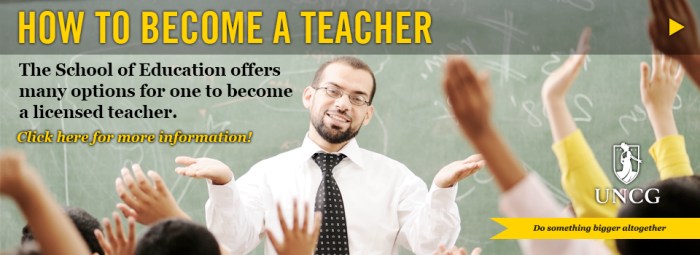
Becoming a highly effective teacher is not a destination but a continuous journey of learning and growth. Ongoing professional development is crucial for staying current with best practices, adapting to evolving student needs, and maintaining a passion for the profession. This commitment to learning ensures teachers remain equipped to inspire and empower students in the ever-changing landscape of education.Continuous professional development is not just about acquiring new skills, but also about refining existing ones and fostering a deeper understanding of pedagogical approaches.
It allows teachers to explore innovative strategies, reflect on their teaching practices, and ultimately, enhance the learning experience for their students. This commitment to growth fosters a culture of excellence and inspires a lifelong love of learning in both teachers and students.
Importance of Ongoing Professional Development
Effective teaching requires a constant evolution of skills and knowledge. The educational field is dynamic, with new research, innovative technologies, and shifting societal needs constantly impacting teaching methodologies. Teachers who prioritize professional development stay abreast of these changes, adapting their practices to meet the diverse needs of their students. This adaptability ensures students receive the most relevant and effective instruction.
Various Professional Development Opportunities
A wide array of professional development opportunities are available to teachers, catering to various interests and needs. These include workshops, conferences, online courses, mentorship programs, and collaborative learning experiences. These avenues allow teachers to delve into specific topics, explore new pedagogical approaches, and gain valuable insights from experienced educators. These opportunities also offer networking opportunities with colleagues, fostering a supportive and enriching professional environment.
- Workshops and Conferences: These offer focused training on specific skills or topics, often presented by experts in the field. They provide hands-on experiences and practical strategies that can be immediately implemented in the classroom. Examples include workshops on differentiated instruction, technology integration, or specific subject matter expertise.
- Online Courses and Modules: These provide flexible and accessible learning opportunities, allowing teachers to pursue professional development at their own pace. Many online platforms offer courses covering a range of topics, from classroom management to curriculum design, ensuring teachers can stay updated on current trends.
- Mentorship Programs: Experienced educators can provide guidance and support to newer teachers, offering insights into best practices and classroom management techniques. Mentorship programs often include structured meetings and collaborative projects, fostering a strong sense of community and shared learning.
- Collaborative Learning Experiences: Peer-to-peer learning is vital for teachers. Workshops and conferences, or even informal discussions among colleagues, offer opportunities to share experiences, strategies, and resources. This sharing can foster creativity, problem-solving, and mutual support.
Staying Updated with Current Educational Trends and Research
Keeping abreast of current educational trends and research is essential for effective teaching. Teachers should actively seek out and engage with educational publications, journals, and online resources to stay informed about new research and best practices. Attending conferences, participating in professional organizations, and joining online communities dedicated to education are other ways to stay updated.
- Educational Journals and Publications: Staying current on research and best practices in education requires regular engagement with journals and publications that focus on pedagogical research and contemporary issues. Examples include journals like “Educational Researcher,” “American Educational Research Journal,” and “Teaching and Teacher Education.”
- Educational Conferences and Workshops: Attending conferences and workshops provides opportunities to learn from leading experts, network with colleagues, and gain insights into cutting-edge trends and strategies.
- Professional Organizations: Joining professional organizations dedicated to education allows access to resources, networks, and ongoing professional development opportunities, such as webinars, online courses, and conferences. The National Education Association (NEA) and the American Federation of Teachers (AFT) are examples of such organizations.
Collaboration and Mentorship for Teacher Growth
Collaboration and mentorship play a vital role in a teacher’s professional development. Mentorship provides a supportive relationship with an experienced teacher, offering guidance and feedback on teaching practices. Collaborative efforts with colleagues allow teachers to share ideas, resources, and support, leading to enhanced classroom instruction and a greater sense of community. Sharing best practices fosters innovation and mutual respect within the educational community.
Wanting to become a teacher? It’s a rewarding career path, but navigating the complexities of education requires careful consideration. Recent reports, like the one detailing Google’s government surveillance, highlight the growing importance of privacy and free speech in our digital age. This raises important questions about the ethical implications of technology in the classroom and the need for teachers to stay informed.
Ultimately, becoming a teacher means understanding these societal issues, and finding ways to engage students in a responsible, digital world, so you can prepare the next generation for a future where privacy and free speech are paramount. googles govt surveillance report stirs privacy free speech fears. A good starting point is always research and pursuing the right certifications.
Reputable Organizations and Resources for Teacher Professional Development
Numerous organizations and resources offer high-quality professional development opportunities for teachers. These include national and state education associations, university-based teacher training programs, and online platforms. Seeking out reputable organizations ensures that teachers receive valuable and well-researched training.
- National Education Association (NEA): A large professional organization for teachers that offers various resources, including professional development opportunities, advocacy efforts, and networking opportunities.
- American Federation of Teachers (AFT): Another significant professional organization for teachers providing support, advocacy, and professional development opportunities.
- National Council on Teacher Quality (NCTQ): This organization focuses on teacher quality and effectiveness, providing resources, research, and publications to support teachers in improving their practice.
- Professional Development Websites and Platforms: Various online platforms, such as Coursera, edX, and FutureLearn, offer a wide range of courses and resources related to education, enabling teachers to enhance their skills and knowledge.
Finding Teaching Positions
Landing a teaching position requires more than just qualifications. It’s a process that demands strategic planning, a well-crafted application, and a confident approach to interviews. This section delves into the practical steps needed to successfully navigate the job search for educators.Finding the right teaching position involves proactive research and a keen understanding of the application process. Knowing where to look and how to present yourself effectively are crucial elements in securing a teaching role.
This guide will illuminate these key areas, equipping you with the tools to succeed in your job hunt.
Researching and Identifying Teaching Positions, How to become a teacher
Locating suitable teaching positions requires diligent research. Effective strategies include exploring online job boards specific to education, contacting schools directly, and networking with educators. Utilizing online job boards like Indeed, K12 Jobs, and specific state education websites is essential. School districts often post openings on their websites, allowing for direct application and a tailored approach. Networking with teachers, school administrators, and alumni from your educational background is invaluable.
These connections can provide insider information and lead to hidden opportunities.
So, you’re dreaming of a career as a teacher? It’s a rewarding path, but it’s also about embracing the learning process yourself. Like any ambitious project, teaching requires careful planning, and that includes understanding how to test your approach—or, as the insightful article plan your projects testing or plan to fail suggests, to plan for potential failures.
Ultimately, the key to becoming a great teacher lies in constant self-improvement and a willingness to adapt, adjusting your methods based on real-world experiences. Keep experimenting, keep learning, and keep growing.
Application Process for Various Teaching Roles
The application process varies depending on the teaching role. Understanding the specific requirements of each position is crucial. This includes reviewing the job description meticulously, ensuring your qualifications align with the listed requirements. Tailoring your application materials to the specific needs of each position is vital. Demonstrate a clear understanding of the school’s mission and values, showing your commitment to their educational philosophy.
Crafting a Strong Resume and Cover Letter
A compelling resume and cover letter are essential components of a successful application. The resume should highlight relevant skills, experience, and accomplishments. Use action verbs to describe your achievements and quantify your accomplishments whenever possible. A well-written cover letter should express your enthusiasm for the position and articulate how your skills and experience align with the specific needs of the school.
Showcasing your passion for education and your commitment to student success is key.
Interview Process and Common Interview Questions
The interview process is a crucial opportunity to showcase your skills and personality. Be prepared to discuss your teaching philosophy, classroom management strategies, and your approach to student learning. Common interview questions delve into your experience, your understanding of education, and your ability to work within a team. Anticipating and practicing responses to common questions, like “Tell me about yourself,” “Why are you interested in this position,” and “Describe a time you faced a challenging student,” is important.
Essential Documents for a Teaching Application
The following table Artikels essential documents needed for a teaching application.
| Document | Description |
|---|---|
| Resume | A concise summary of your qualifications, experience, and skills, tailored to the specific position. Highlight relevant coursework, teaching experience, and professional development. |
| Cover Letter | A personalized letter expressing your interest in the position, showcasing your enthusiasm for the school’s mission and aligning your skills with the specific requirements of the job description. Demonstrate your understanding of the role and your commitment to student success. |
| Transcripts | Official academic records demonstrating your educational background and qualifications. These should be official documents from the issuing institution. |
| Letters of Recommendation | Letters from previous professors, supervisors, or mentors attesting to your skills, experience, and character. Ensure these letters highlight specific qualities relevant to teaching. |
| Teaching Portfolio (Optional) | A collection of samples demonstrating your teaching abilities, such as lesson plans, student work samples, and assessments. This showcases your practical skills and methodologies. |
The Teacher’s Role in a Diverse Classroom
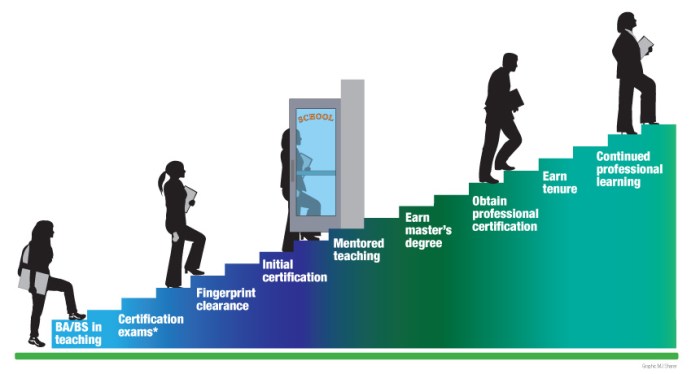
Teaching in a diverse classroom is a rewarding but complex undertaking. It requires understanding and embracing the unique needs and backgrounds of each student. Teachers must move beyond simply acknowledging diversity to actively creating a learning environment that fosters inclusivity and empowers every student to reach their full potential. This necessitates a deep understanding of cultural backgrounds, learning styles, and potential disabilities, as well as the development of strategies to address the specific needs of English Language Learners (ELLs).
Creating an Inclusive Classroom Environment
A truly inclusive classroom environment is built on respect, empathy, and a shared understanding of the diverse backgrounds and experiences of students. Teachers can foster this environment by actively seeking to understand each student’s background, actively listening to their perspectives, and demonstrating a genuine interest in their lives outside of the classroom. This creates a safe and welcoming space where students feel valued, respected, and empowered to participate fully in the learning process.
Culturally Responsive Teaching Practices
Culturally responsive teaching goes beyond simply acknowledging cultural differences; it integrates those differences into the curriculum and teaching methods. This approach recognizes that students’ cultural backgrounds shape their learning styles, values, and perspectives. Teachers who employ culturally responsive teaching practices demonstrate an understanding of different cultural norms, and incorporate these insights into lesson plans, classroom management, and interactions with students.
For example, incorporating literature and perspectives from various cultures into the curriculum can enhance engagement and broaden students’ understanding of the world.
Understanding Diverse Learning Styles
Students learn in a variety of ways, and recognizing these different learning styles is crucial for effective teaching. Visual, auditory, and kinesthetic learners require varied instructional approaches. Visual learners respond well to diagrams, charts, and images; auditory learners thrive in discussions and lectures; and kinesthetic learners benefit from hands-on activities and experiments. Teachers must incorporate a variety of teaching methods to accommodate the diverse learning styles in their classroom.
Addressing the Needs of Students with Disabilities
Students with disabilities may require accommodations and modifications to succeed in the classroom. Teachers must understand and implement these accommodations, ensuring that students with disabilities have equal access to learning opportunities. This may include modifying assignments, providing assistive technology, or adapting instructional strategies. Teachers must collaborate with special education professionals to create individualized education programs (IEPs) and ensure that all students have the support they need to reach their full potential.
For example, a student with dyslexia might benefit from audiobooks, alternative assessments, or extra time on assignments.
Supporting English Language Learners (ELLs)
English Language Learners (ELLs) face unique challenges in the classroom. Teachers must provide appropriate support to help them develop their English language skills while also ensuring they keep up with their academic progress. This might involve providing access to bilingual resources, creating opportunities for peer interaction, and incorporating visual aids and real-world examples into lessons. Teachers can also utilize strategies such as sheltered instruction, which provides a modified approach to teaching subject matter in English while simultaneously providing support with language acquisition.
For example, utilizing visual aids or providing vocabulary support during instruction can help ELLs comprehend and participate in the lesson.
Technology Integration in the Classroom
Embracing technology in the classroom is no longer a luxury, but a necessity for effective teaching and learning. Integrating technology thoughtfully and strategically can transform the learning experience, fostering engagement, creativity, and personalized learning opportunities for students. By leveraging digital tools and resources, teachers can create interactive and dynamic lessons that cater to diverse learning styles and accelerate knowledge acquisition.Technology integration is not simply about using computers or tablets; it’s about using technology as a powerful tool to enhance pedagogical approaches.
This involves thoughtfully selecting appropriate tools, aligning them with learning objectives, and ensuring equitable access for all students. A well-integrated approach will equip students with the digital literacy skills needed to thrive in the 21st-century world.
Different Ways to Integrate Technology in Lesson Planning
Effective technology integration goes beyond simply adding digital tools to existing lessons. It requires a shift in mindset, recognizing technology as a facilitator of learning, not just a delivery mechanism for information. Teachers should consider technology as a tool to engage students in active learning, promote collaboration, and cater to diverse learning styles. This requires incorporating technology seamlessly into the lesson plan, not as an add-on, but as an integral part of the learning experience.
Examples of Digital Tools and Resources for Teachers
A vast array of digital tools and resources are available to support effective teaching. These tools can range from simple presentation software to sophisticated educational platforms.
- Interactive Whiteboards: These tools allow teachers to create dynamic presentations, engage students in real-time activities, and facilitate collaborative learning experiences. They offer a versatile platform for displaying information, prompting discussions, and showcasing student work. Examples include SMART Boards and Promethean Boards.
- Learning Management Systems (LMS): Platforms like Google Classroom, Canvas, and Moodle offer a centralized hub for organizing materials, assigning tasks, communicating with students and parents, and tracking student progress. They provide a streamlined way to manage assignments, feedback, and communication.
- Educational Apps and Software: Numerous apps and software cater to various subjects and learning styles. These tools often incorporate interactive exercises, simulations, and multimedia elements, making learning more engaging and interactive. Examples include Khan Academy, Quizizz, and BrainPop.
- Online Research Databases: Students can use online research databases to access reliable information and expand their understanding of various topics. Databases like JSTOR and EBSCOhost provide comprehensive collections of articles, journals, and other scholarly resources. This fosters critical thinking and research skills.
Benefits of Using Technology for Student Engagement
Technology offers numerous avenues for enhancing student engagement and motivation. Interactive simulations, virtual field trips, and multimedia presentations can capture students’ attention and create a more dynamic learning environment.
- Increased Motivation: Interactive learning experiences can spark curiosity and motivate students to actively participate in the learning process. This active engagement is often more effective than passive listening.
- Personalized Learning: Technology allows teachers to tailor learning experiences to individual student needs and preferences. Adaptive learning platforms and personalized learning paths can help students progress at their own pace.
- Enhanced Collaboration: Online tools facilitate collaboration among students, encouraging teamwork, communication, and shared learning. Students can work together on projects, share ideas, and provide feedback in virtual environments.
Strategies for Using Technology for Assessment and Feedback
Technology can streamline assessment processes and provide valuable feedback to students. Digital tools can automate grading, offer immediate feedback, and provide opportunities for self-reflection.
- Automated Grading: Tools like Google Forms and Quizizz can automate the grading of quizzes and assessments, freeing up teachers’ time to focus on providing personalized feedback.
- Immediate Feedback: Online quizzes and interactive exercises often provide immediate feedback to students, allowing them to identify areas where they need improvement and adjust their learning accordingly.
- Data-Driven Insights: Technology allows teachers to collect and analyze data on student performance, providing valuable insights into student strengths, weaknesses, and learning patterns. This data can guide instruction and inform future learning strategies.
How to Create Interactive Learning Experiences Using Technology
Interactive learning experiences are essential for student engagement. Technology provides the tools for creating dynamic and engaging lessons that go beyond traditional methods. Incorporating interactive elements makes learning more active and memorable for students.
- Interactive Simulations: Incorporate simulations to provide students with opportunities to explore complex concepts and scenarios in a safe and controlled environment. This method allows students to experiment and discover, leading to a deeper understanding of the subject matter.
- Virtual Field Trips: Take students on virtual field trips to museums, historical sites, or other locations that might be inaccessible in person. This expands their learning beyond the classroom walls.
- Multimedia Presentations: Employ multimedia elements such as videos, audio clips, and images to make lessons more engaging and appealing. This method also caters to different learning styles.
Final Review
In conclusion, becoming a teacher is a multifaceted journey requiring careful planning, dedication, and a genuine passion for education. This guide provides a solid foundation for aspiring educators, equipping them with the knowledge and skills needed to succeed. By understanding the necessary requirements, developing essential skills, and embracing continuous professional growth, aspiring teachers can embark on a fulfilling career dedicated to nurturing the minds of the next generation.
The path to becoming a teacher is paved with preparation, passion, and perseverance.

